
















brady@spotlightmediafargo.com


















brady@spotlightmediafargo.com
Bison Pride isn’t something you can fully explain to someone who hasn’t felt it, but if you’ve ever stood in the Fargodome on game day, you know exactly what it means. It’s the buzz before kickoff. The sea of green and gold. The collective energy of a community that shows up, win or lose (when that rarely happens).
North Dakota State has built something special. The championships, the rivalries, the national spotlight—all of that matters, but the real story is what’s behind it. It’s the athletes who balance classes and competition with relentless commitment. It’s the coaches who shape leaders. And it’s the fans who travel, cheer, and keep

the Bison spirit alive wherever they go.
Supporting the Bison means believing in that standard. It means taking pride in a program that represents the best of what this region stands for—hard work, humility, and heart. Whether it’s football, basketball, track, volleyball, or
any other sport, every athlete wearing that jersey carries a piece of something bigger than themselves.
What makes Bison Pride powerful is that it doesn’t fade when the lights go out or the season ends. It’s in the alumni who still wear green on Saturdays, the parents in the
stands, and the next generation of kids dreaming about running onto that field someday.
Supporting the Bison means carrying that pride forward—not just for the wins, but for the values that built them.



Kellen
Sarah
Paul Hoefer Paul@SpotlightMediaFargo.com
Al Anderson Al@SpotlightMediaFargo.com
Austin Cuka
AustinCuka@SpotlightMediaFargo.com
Matt Purpur Matt@SpotlightMediaFargo.com
ClientRelations@SpotlightMediaFargo.com Jessica Ventzke Tyler Duclos
John Stuber
















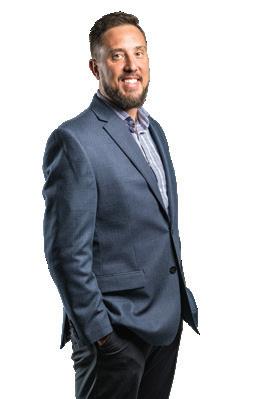







We always hear that the people are what make the Fargo-Moorhead community great. So, why not meet them? Each month we cover a different topic led by local voices. We meet advocates, experts, and people just like you!
meetfargo.com /meetfargo @meetfargo @meetfargo


Growth Leaders is one of Spotlight's annual publications dedicated to showcasing our local companies and the services they bring to the Fargo-Moorhead area.


Fargo INC! is our very successful business magazine which covers all things business in the Fargo-Moorhead area.
fargoinc.com facebook.com/fargobusiness Twitter: @fargoincmag LinkedIN: Fargo INC
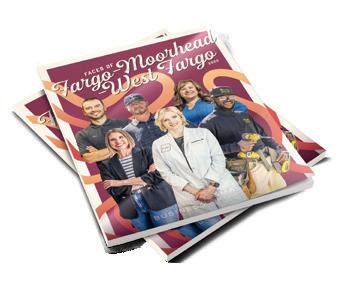
You may already be familiar with our Faces of Fargo-Moorhead-West Fargo publication which we publish once per year in order to highlight the faces behind all of the great businesses in the community.
Future Farmer is our farming publication which brings great tech-focused content to readers across North Dakota and Minnesota.
futurefarmermag.com /FutureFarmerMag

Are you in need of a new career? The Great Places to Work Fargo-MoorheadWest Fargo Annual Career Guide highlights amazing businesses in the area that provide great growth opportunities, benefits, and more!

e’re taking a closer look at the people who make Bison football what it is—both on the field and on the sidelines. From the coaches who craft game plans and shape the culture to the players who carry out every play with grit and precision. In the pages ahead, you’ll get to know the leaders, the rising talents, and the personalities that drive the team forward.


BY BRADY DRAKE





an Larson serves as the Offensive Coordinator for North Dakota State University, where he blends years of coaching versatility with the tradition of Bison football excellence. Since arriving in Fargo in 2019, Larson has worked with running
Q: BEING NAMED OFFENSIVE COORDINATOR—THAT’S GOT TO BE PRETTY EXCITING, I HAVE TO IMAGINE.
A: I think having the opportunity to continue in a role that helps move the program forward is always special. I’m excited about the leadership opportunity—getting to be around every guy on offense, not just the offensive line like in the past.
Q: IS THERE ANYTHING DIFFERENT YOU’RE HOPING TO BRING TO THE OFFENSIVE PHILOSOPHY HERE?
A: Not really. I think NDSU football has always worked well when coaches can be themselves, and players can be themselves. Then, when it’s time to focus and move in the same direction, everyone is aligned. The biggest thing for me is continuing that “compete and improve” mentality—the toughness and physicality. That part won’t change. Those are the ingredients that have always been the secret to NDSU’s success.
backs, guided the offensive line, and now oversees the entire offensive system while directly coaching tight ends and fullbacks. A former head coach at Wisconsin-Eau Claire and offensive coordinator at MinnesotaDuluth, Larson carries a proven record
Q: ON A LARGER SCALE, WHAT DO YOU LOVE ABOUT FOOTBALL?
A: It’s the teammates—the brotherhood. It’s the connection you have with each other. And it’s the fact that we only get one opportunity a week to go out there. Every other sport gets multiple games. We get one. That challenge is second to none. You work hard all week—five days for three hours of practice, four times a week—for just 30 to 35 minutes of football on a Saturday. The correlation doesn’t always make sense to the outside eye, but it makes football unique. When you win, the reward is incredible. When you come up short, you have to go right back to work, right back to the process, and find ways to do it better. That challenge and reward cycle is what makes football different.
A: I’d say I’m detail-oriented, passionate, and driven by the idea that we can always do something a little bit better. I don’t ever want to settle
of leadership and program building into his current role. Under his direction, the Bison offense continues to evolve with the balance, toughness, and efficiency that define championship football.

for ‘good enough.’ I make sure all the i’s are dotted and t’s are crossed, and I demand that we’re as competitive as possible. That competitiveness bleeds into the mentality—it can always be better. Even after 24 years in this profession, that’s still a motivation for me—that we haven’t put our best football game out there yet. At the same time, you have to balance that with being supportive. You’ve got to push guys, but also pat them on the back when they need it. Growing up in a small-town high school, coaches challenged us hard because they believed in us. That’s still my philosophy. Our players know we love them, but we’re going to challenge them to be better. That balance— between demanding excellence and embracing your players—is one of the most rewarding parts of coaching. Honestly, sometimes even more rewarding than the victories.



ylan Chmura joined the North Dakota State University coaching staff in February 2025 as the Offensive Line Coach, taking charge of one of the most physically demanding and technically exacting position groups on the field.
In this role, Chmura is responsible for developing the Bison offensive linemen’s technique in pass protection,
Q: WHAT’S IT LIKE BEING AT NDSU?
A: Well, it’s interesting—this is my first time on staff, but I spent two years at Iowa with Coach Polasek. Now, coming back here and being trusted with the offensive line group is an amazing experience. Everything you see from the outside—the way things are done, the way Bison pride echoes through the history of this program— it’s incredibly special. Leading the O-line room every day means a lot to me. It’s amazing to be in Fargo and to be part of such a great program.
Q: I HAVE TO IMAGINE THAT EXPERIENCE AT IOWA HELPED PREPARE YOU FOR THIS. BIG TEN SCHOOL, BUT A REALLY HIGH STANDARD HERE, TOO.
A: Absolutely. I’ve been really fortunate to learn from some amazing
run blocking, footwork, hand placement, communication, and cohesion up front.
Chmura comes into this job with a broad and growing résumé: in 2024 he coached the offensive line at Tennessee State; he held the same position at Bemidji State in 2023; and in 2021–22 he served at Northern Michigan, where his duties included coaching tight ends
mentors. Getting to continue learning under Coach Polasek here, just like I did at Iowa, has been an incredible experience. It pushed me in the right direction with offensive line play— understanding how and why we do things and continuing to polish that. Being part of that at Iowa was a very fortunate step in my career.
Q: HOW DO YOU THINK YOU’VE GROWN THE MOST AS A COACH OVER THOSE THREE YEARS?
A: That’s a good question. Coaching is unique—you learn so much by doing it. As a GA or an assistant, you take notes about what you’d do if you ever get the opportunity. But once you’re actually in the role, you realize you have to adapt. Different players learn in different ways. You might say something one way and it clicks immediately for one guy, but you need to phrase it differently for another. At its core, coaching is about inspiring
and fullbacks, and he also took on coordinator and interim head coaching roles.
Earlier in his career, he worked as a graduate assistant at Iowa (2019-20) under a respected offensive line staff, and as a student assistant/volunteer at Michigan State and Fresno State.

learning. You have to communicate the same idea in different ways— changing your tone, your phrasing—so each player can absorb it. That’s really what teaching is about.
Q: HOW DO YOU FIGURE OUT HOW EACH PLAYER LEARNS BEST?
A: A lot of it comes from being on the ground with them. In meetings, I’ll look at their notes or see how many questions they ask. With veterans, it’s about stacking knowledge—getting them to 2.0, 3.0, 4.0 thinking. For younger guys, it might be their first or second time through, so you have to scale it back. Sometimes I’ll say something in the classroom, but it needs more polish on the field. Then I’ll circle back and ask, ‘What did you hear? How did that feel?’ Hearing their feedback helps guide how I teach.



Q&A WITH QUARTERBACKS COACH
oe Beschorner has stepped into the role of Quarterbacks Coach for North Dakota State University for the 2025 season, bringing with him a versatile offensive coaching background and a track record for building dynamic units.
He first joined the Bison staff in 2021 as Running Backs Coach, transitioned in 2024 to coach Tight Ends and Fullbacks while also becoming the Special Teams Coordinator, and now takes charge of the quarterbacks.
Q: YOU’VE KIND OF JUMPED AROUND THE COACHING STAFF, AND NOW YOU’RE WITH THE QUARTERBACKS. HOW DID THAT TRANSITION HAPPEN?
A: I coached quarterbacks for 13 years before I got here. From a staff perspective, just like on offense, where you want to put your players in the best position to succeed, you want to do the same with your coaches. It was just the best fit for our staff.
Q: YOU’VE WORKED WITH A LOT OF DIFFERENT POSITION GROUPS. HOW DO YOU THINK THAT’S HELPED YOU AS YOU COME BACK TO QUARTERBACKS?
A: Anytime you can look at the game from multiple perspectives— offensive line, running backs, tight ends, quarterbacks—it gives you a more holistic vision of how everything fits together. One of the best things that happened in my career was at South Dakota. My last year there, I coached the secondary.
Beschorner’s experience includes 13 years as an offensive coordinator at Simpson College and Minnesota State-Mankato, during which he oversaw some of the most productive scoring and rushing attacks in Division II.
At NDSU, he is expected to apply that experience by helping quarterbacks master decisionmaking, accuracy, reading defenses, and integrating their play into the Bison’s offensive scheme.

Going from defense back to offense really opened my eyes and helped me become a better offensive coach.
Q: I IMAGINE HAVING TO LEARN ALL THE TECHNIQUES—ESPECIALLY IN THE SECONDARY— JUST DEEPENS YOUR KNOWLEDGE OF THE GAME.
A: Exactly. The longer you study the game, it’s like peeling back an onion. You just keep uncovering layers and gaining more knowledge.
Q: THE AVERAGE FAN PROBABLY KNOWS SOME BASICS OF WHAT MAKES A STRONG QUARTERBACK. WHAT DO YOU THINK ARE SOME LESSER-TALKEDABOUT TRAITS?
A: All great quarterbacks have unbelievable athletic awareness. They’re the type who maybe don’t play much golf but could go beat you in golf, pickleball, or ping pong. They just have great spatial awareness, timing, and a knack for leverage and space—the things that make great athletes and quarterbacks.



am Ojuri returned home in February 2025 to take over as Running Backs Coach at North Dakota State University, the school where he starred as a player.
In this role, he is tasked with mentoring and developing the Bison tailbacks in all facets—from technique in ball security, footwork, vision, pass protection, and explosive cuts, to conditioning and mental preparation.
Q: WHAT’S IT LIKE BEING BACK AT NDSU?
A: For me, it’s a dream come true. When I first started coaching, this was the spot I wanted to get back to—the place I played. It’s been awesome.
Q: WHAT’S IT LIKE COACHING RUNNING BACKS, ESPECIALLY WITH ALL THE DIFFERENT STYLES? IT SEEMS LIKE SUCH A UNIQUE POSITION BECAUSE EVERYONE APPROACHES IT DIFFERENTLY. YOU HAD YOUR STYLE WHEN YOU PLAYED, BUT NOW YOU’RE WORKING WITH GUYS WHO EACH HAVE THEIR OWN. HOW DO YOU HANDLE THAT?
A: Running backs come in all sizes and styles, but at the end of the day, there are three things I want from
While at NDSU (2009-2013), Ojuri was a key contributor on multiple FCS championship squads, finishing among the school’s all-time leaders in rushing yards, all-purpose yards, and touchdowns.
After his playing career (which included time in the Canadian Football League), he moved into coaching — working at high school, Division III (Wisconsin-Stevens Point), then as a
them: break tackles, protect in pass pro, and catch the ball. We can build from there. The most important thing is putting them in the best position to succeed based on their skill set.
Q: WHAT DO YOU THINK YOU SPECIFICALLY BRING TO THE RUNNING BACK ROOM?
A: I bring the experience of being in that room before—the pride it takes to be an NDSU running back. I bring development, on and off the field. I feel like these guys have gotten better every day under my coaching, and that’s the biggest thing. As long as we’re finding ways to compete and improve, I want to develop them to their fullest potential.
Q: IN YOUR OPINION, HOW HAS THE COLLEGE GAME CHANGED SINCE YOU WERE PLAYING?
A: That’s what’s so great about NDSU— not much has changed. The offense is
graduate assistant at Wyoming, and spending several seasons coaching running backs at Illinois State.
In his current job, Ojuri not only aims to build Bison backs who can execute physically and reliably on Saturdays, but also to instill in them the program’s standard of toughness, work ethic, and consistency.

still the same as when I played, so I can lean on that experience. The biggest change is the speed of the game, especially with the running clock. Games go by faster now. That’s why I harp on explosives—sooner, the better. Start fast and finish even faster.
Q: SO THE TERMINOLOGY AND STRUCTURE ARE STILL THE SAME?
A: Exactly. The formations, the terminology—it’s all the same. That made it really nice coming back, because I was already familiar with the lingo. It felt like riding a bike.



ody Morgan returned to North Dakota State University in July 2025 to assume the role of Defensive Tackles Coach, replacing longtime assistant coach Nick Goeser.
In this position, Morgan is responsible for coaching the defensive tackle group—teaching technique, scheme,
Q: WHY DID YOU CHOOSE TO COME BACK TO NDSU?
A: Honestly, the decision was easy. Fargo has always felt like home for my family—my wife and I love this community, and we really missed it when we were away the last two years. But the number one reason was Coach Polasek. He’s been a mentor and a dear friend since I was nine years old—he was actually my little league baseball coach. He’s helped me with every step of my career, and I know the type of man he is. I knew I wanted to be part of something special with him again.
Q: HE WAS YOUR LITTLE LEAGUE COACH?
A: Yep. He’s from Scandinavia, Wisconsin, and I’m from Iola, Wisconsin. It’s one small high school— Iola-Scandinavia. The combined towns probably have 1,200 or 1,300 people. But there’s a ton of pride there. Guys like Nick Goeser and Tim Polasek— we’re all from that high school. People even joke that it’s the “cradle of coaches.” At one point, 16 to 18 guys from that school were coaching in college football.
A big part of that is Coach Polasek’s influence, but also our high school coach, Scott Erickson. If he doesn’t go
run fits, pass rush fundamentals, block recognition, and helping players develop strength and consistency at the point of attack.
Morgan brings to the role a wealth of relevant experience: he previously coached cornerbacks and safeties at NDSU, served as special teams coordinator, and most recently was
into the Wisconsin Football Coaches Hall of Fame, it would be a tragedy. He was an unbelievable coach and mentor.
Q: WHAT DID COACH ERICKSON TEACH YOU SPECIFICALLY?
A: He was a short guy with glasses, kind of unassuming, but to middle schoolers getting ready for high school football, he was the most intimidating man alive. You always wanted to do right by him. The lasting impression he left on me was that he was always around. He’d be at middle school practices, games, in the weight room—no matter the time of day. He was present, he cared, he talked to us, pushed us. That constant presence and respect he commanded set the tone for all of us.
Q: YOU’VE COACHED A LOT OF POSITIONS AND AT DIFFERENT LEVELS. WHAT DID YOU LEARN MOST RECENTLY AT KENT STATE?
A: Stepping into a defensive coordinator role was huge. First, I learned it’s not as easy as people think. But more importantly, I learned how to command a room—not just with 18- to 22-year-olds, but with grown professionals, some with more
with Kent State where in 2024 he was their defensive coordinator.
He has been part of several championship-winning Bison squads and is well-versed in the standards and culture of NDSU football.

experience or knowledge than me. You have to earn respect and lead anyway. That experience taught me what it takes to be a coordinator, but also what it takes to be a really good assistant. Now, back here, I know my role: to give Coach Olson everything he needs, make his job easier, and be the best assistant I can be.
Q: DID BEING A COORDINATOR GIVE YOU MORE INSIGHT INTO WHAT OLSON NEEDS FROM YOU NOW?
A: Absolutely. I remember sitting in that chair, wanting things from assistants that I didn’t always get. Now I know I’ve got to do everything possible to help him, anticipate what he needs, and lighten his load.
Q: WHAT EXCITES YOU MOST ABOUT THE GROUP YOU’RE WORKING WITH NOW?
A: I love this defensive tackle group. Forget football for a second—these are outstanding young men. Mature, tightknit, they care about each other, they hang out together.



Q: YOU PLAYED MULTIPLE SPORTS GROWING UP—HOW DO YOU THINK THAT HELPED YOUR FOOTBALL CAREER?
A: I think every kid should play a lot of sports. First, it keeps you from burning out. Second, every sport builds different skills—hand-eye coordination in baseball, agility and anticipation in basketball, and footwork in soccer. Playing multiple sports just makes you a better athlete once you focus on one. I played football, baseball, basketball, and soccer growing up. In high school, I stuck with football and baseball, and in the winters, I spent a lot of time in the weight room getting bigger, stronger, and faster. Playing different sports was huge for my development.
Q: YOU HAD A LOT OF SUCCESS IN HIGH SCHOOL, BUT THEN CAME HERE AND HAD TO PLAY IN A MORE LIMITED ROLE. WHAT WAS THAT EXPERIENCE LIKE— PROBABLY THE FIRST TIME IN YOUR LIFE YOU HAD TO GO THROUGH THAT?
A: Yeah, for sure. It’s a wake-up call for everyone coming into college.

You go from being ‘the guy’ to being at the bottom and having to earn a role. For me, that was being a backup. I worked hard to expand that role into something more, to be someone the team could rely on to make plays when needed. But yeah, it’s a quick lesson for all of us—you’ve got to earn everything.
Q: WHAT WAS THE BIGGEST THING YOU NEEDED TO IMPROVE WHEN YOU GOT HERE?
A: Honestly, just learning football. You think you know the game in high school, but then you get to college and realize how complex it is. There are a million ways to get to the same look. So many moving parts. That’s what makes football the ultimate team sport. I had to learn to be a quarterback—not just an athlete. That was the wake-up call—how complex the position is.
Q: DID YOU EVEN HAVE CHECKS IN HIGH SCHOOL?
A: Not really. Maybe one or two. It was usually just, ‘I’m going to throw a fade or a slant to my best receiver.’ In college, it’s completely different— you’re setting protections, adjusting
runs, reading defenses. None of that happens in high school.
Q: HOW LONG DID IT TAKE TO FEEL LIKE YOU HAD COMMAND OF THAT?
A: A couple of years. By my second year, as the backup, I had to step up. Each year since then, it’s been about building confidence—getting bigger, stronger, and faster in the weight room, watching film, getting more reps. It takes time, and then you also go through coaching changes where different coaches want things done different ways. There’s always learning and growth.
Q: WHAT WAS IT LIKE BEING SIDELINED WITH INJURY LAST YEAR?
A: Honestly, it sucked. Injuries are part of the game, but it’s brutal when something you love gets taken away in a second. It taught me not to take things for granted—even fall camp, as tough as it is, is way more fun than standing on the sideline. Shoutout to our athletic training staff, too. They poured into us—the guys with surgeries and injuries—and got us ready to compete again.






Q: TRANSFERRING HAD TO BE A HARD DECISION. HOW LONG DID YOU THINK ABOUT IT, AND WHAT WENT INTO THAT?
A: It was going into my second spring ball, the end of my second season at Marshall. I was weighing my options, trying to find a path to the field. I felt like it might be better to get an opportunity somewhere else and start fresh. So I hit the portal, and luckily it turned out to be one of the best decisions I’ve ever made. I came here, started, won a national championship, and joined a team with amazing chemistry. Seeing the hard work every day and feeling the pride this program has—it’s unique. You really experience what ‘Bison Pride’ means here.
Q: HOW OLD WERE YOU WHEN YOU TRANSFERRED?
A: I was 20.

DID YOU KNOW?
Q: THAT’S A HUGE DECISION AT THAT AGE. WHO DID YOU LEAN ON FOR ADVICE?
A: Mostly my parents. My dad, especially, since he’s knowledgeable about football. It wasn’t something I planned on doing when I first went to Marshall, but after thinking about it for a while, we figured it was the best move for my future.
Q: HOW OFTEN DO YOU GO TO YOUR DAD FOR FOOTBALL ADVICE?
A: Pretty often. If I’m struggling with something, I’ll talk to him. Even after games, I’ll get a text—’Hey, you should’ve done this better.’ It’s like having another coach in my life, and I’m fortunate for that.
Q: WHAT’S THE BIGGEST THING HE’S TAUGHT YOU?
A: From a young age, he instilled hard work. Summers meant going to the field, lifting, working on football— basically grinding all summer. That started back in elementary and middle school, and it built the foundation I carry with me today.
Q: WHAT DO YOU CONSIDER YOUR BIGGEST STRENGTHS AS A PLAYER?
A: Finishing blocks and playing through the whistle. I take pride in that. Offensive line is about grit—it’s the trenches, and it’s not soft. You have to embrace the physical, nasty side of the game, and I do.



Q: HOW DO YOU THINK YOUR TIME AS A WRESTLER IN HIGH SCHOOL HAS HELPED YOU WITH FOOTBALL?
A: Wrestling is something I’d recommend to any football player in the trenches. It keeps you in shape, it teaches grit, and it helps a lot with hand positioning, body leverage, and balance. You just start to understand those things a lot more. It was definitely really beneficial for me.
Q: DID YOU EVER CONSIDER WRESTLING IN COLLEGE?
A: I had some opportunities to maybe wrestle at the D2 level, but football
has always been my first love. I was more set on football. But I love wrestling. Once the season ends, I go back and help coach. I still have a deep appreciation for it.
Q: WHAT DO YOU LOVE ABOUT FOOTBALL?
A: It’s the only sport where you can literally put your hands on a guy, dominate him, and it’s just part of the game. It’s physical, it’s fun, and it’s a complete team sport. If you don’t have 11 guys on the same page, it’s not going to work. Honestly, it’s in my blood. The day I was born, my dad left the hospital to go coach football practice. It’s been with me since day one.

Q: WHAT DO YOU THINK MAKES A GREAT FULLBACK?
A: Being unselfish. A great fullback is willing to do whatever it takes for the offense to succeed—blocking, catching, whatever’s needed. Unselfish, physical, and full of heart.
Q: WHAT ARE YOUR BIGGEST PASSIONS AWAY FROM FOOTBALL?
A: I really like grilling—though my apartment just banned grills on patios, so I’m upset about that. I also love hanging out at the lake, spending time with my family, and just relaxing.

| OMAHA, NE


Q: WHAT DO YOU THINK GROWING UP IN MARSHALL DID FOR YOU— COMING FROM A SMALLER COMMUNITY?
A: Honestly, it’s one of the biggest reasons I’ve had the success I’ve had. Marshall has, in my opinion— maybe I’m biased—the best youth sports programs around. Growing up, summers weren’t about sitting at home. You biked to baseball, then biked to football, then to basketball practice, then back to weightlifting. At night, you probably had a league game—basketball or baseball. I was always active, and the coaches there really cared about me and poured into me. I’m super grateful for everything they did.
Q: DID THEY HAVE CAMPS YEAR-ROUND, OR WAS IT MORE LEAGUES?
A: All sorts of leagues. For basketball, we had a league and morning workouts. For football, we had sevenon-sevens against other teams and weightlifting. Baseball had practice every morning through something called MAYBA—the Marshall Area Youth Baseball Association. We biked everywhere to get to all of it. For
football, we started a weightlifting program in seventh grade. Basketball had morning workouts and camps all summer. There was always something going on.
Q: WHAT WAS YOUR FAVORITE SPORT GROWING UP?
A: Basketball. I always thought I’d play basketball in college. I even played AAU, so most of my time was spent on basketball. I had some conversations with schools, maybe even could’ve played college basketball. But by sophomore or junior year of high school, football started to take over.
Q: WHY DID YOU DECIDE TO COME BACK FOR THIS SEASON?
A: Honestly, my teammates. I always say I’ll have my whole life to make money, but finishing out my senior year with my brothers and best friends—that’s priceless. That was the biggest deciding factor.
Q: HOW DO YOU LIKE TO LEAD?
A: I’ve always been more of a lead-byexample guy. This year, I’ve taken on

more of a vocal role as a senior, but I think my strength is in showing how things should be done. I’ve learned from great leaders, and I pride myself on doing things the right way. If I can show the younger guys the standard, I think that helps them.
Q: IS IT WEIRD SEEING YOUR FACE ON A BILLBOARD AROUND TOWN?
A: I actually haven’t seen it. Everyone tells me about it, but I haven’t come across it yet. It’s definitely weird to think about.
Q: WHO’S YOUR FAVORITE PLAYER TO WATCH IN THE NFL RIGHT NOW?
A: Good question. My brother’s on the Chargers now, so I’ve been watching a lot of their guys. Ladd McConkey—he’s nasty. I watch practice clips of him all the time. Keenan Allen’s also one of my favorites. I love watching crafty route runners with quick feet. That’s what I’m working toward myself.



Q: WHAT WAS YOUR FAVORITE PLAY FROM LAST SEASON?
A: Definitely the last play against SDSU in the Dakota Marker game—I got an interception to end the game.
Q: HOW DO YOU GO ABOUT MENTORING YOUNGER PLAYERS?
A: I look back at what older guys did for me when I was a freshman. They poured into me, and I try to replicate that. I want to be that same kind of presence for the younger guys—on and off the field—so when this senior class graduates, they’re equipped to step up and lead.
Q: WHO’S YOUR FAVORITE LINEBACKER TO WATCH?
A: Fred Warner. He plays so fast—he’s around the ball on every play. I try

to model my game after him, even though I’m nowhere near as good.
Q: IF YOU COULDN’T PLAY LINEBACKER, WHAT POSITION WOULD YOU WANT TO PLAY?
A: I was a running back in high school and loved it. I’m probably not fast enough to play running back now—or receiver or DB—but if I had to pick, I’d say running back or quarterback. I never played quarterback, but I think it’d be cool to lead the offense. At linebacker, you lead the defense. At quarterback, you get to do that for the whole team, and I like being in those leadership roles.
Q: WHAT DO YOU LIKE ABOUT LEADERSHIP POSITIONS?
A: I like leading by example. I know guys are watching me, and that
pressure makes me perform better. If they’re going to follow what I do, I want to make sure I’m doing things the right way—on and off the field. That accountability has a positive effect on me.
Q: HOW DID PLAYING RUNNING BACK IN HIGH SCHOOL HELP YOU AS A LINEBACKER NOW?
A: It helps a lot. Coach Olson uses this analogy all the time: if you were the running back, where would you go? What gap would you hit? Since I’ve been in those shoes, I can think like a running back. If I see an open hole, I know the running back does too, so I try to beat him there. That perspective helps me make plays—TFLs, stops in the backfield. Putting myself in the running back’s mindset makes me a better linebacker.



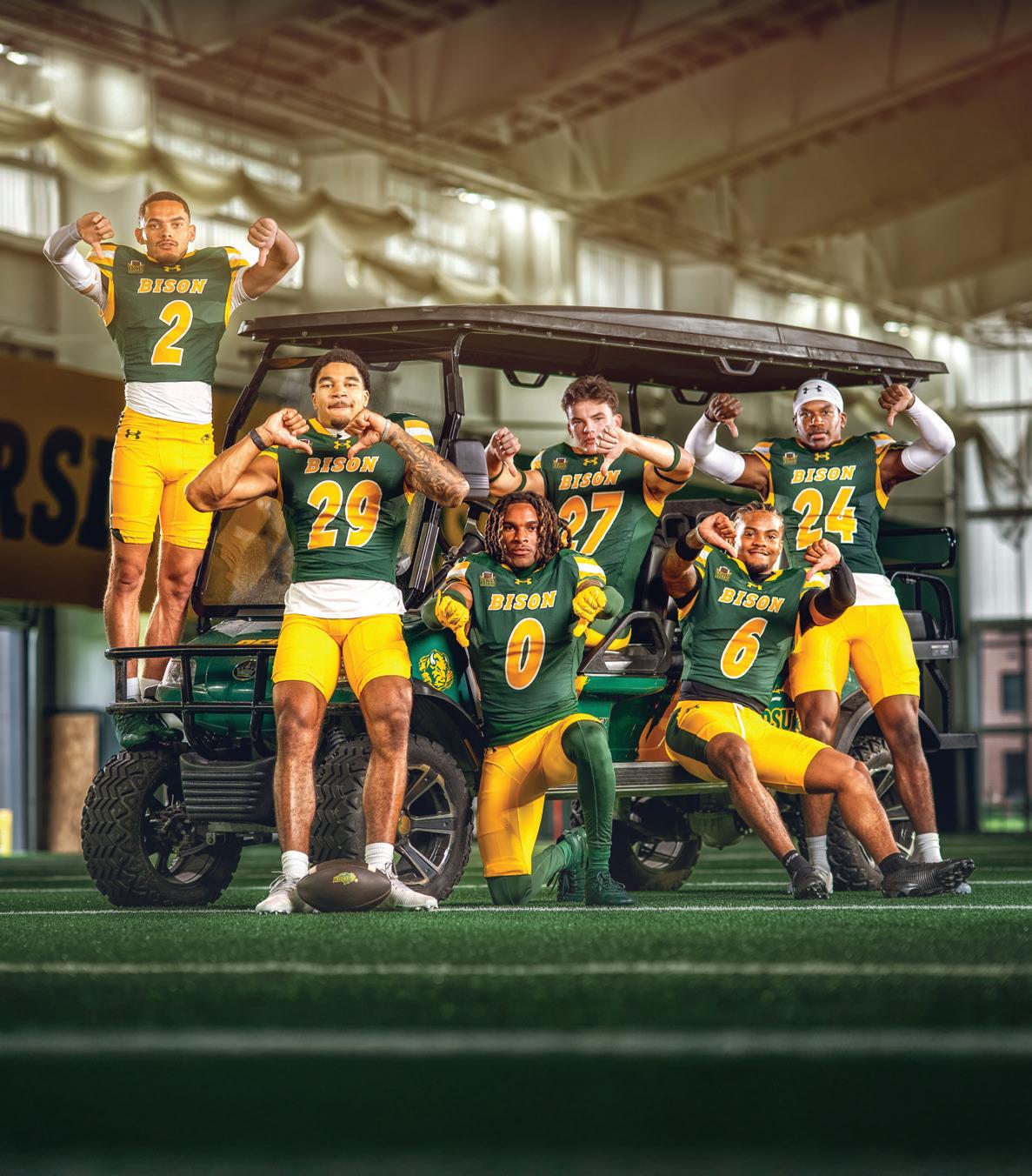
#2 JAILEN DUFFIE
SOPHOMORE | WAUKEGAN, IL

#29 DARIUS GIVANCE
JUNIOR | CHAMPLIN, MN
#27 RYAN JONES
SENIOR | FRISCO, TX
#24 ANTHONY CHIDEME-ALFARO
SENIOR | SACRAMENTO, CA
#0 JAQUISE ALEXANDER
JUNIOR | RUSKIN, FL
#6 JAYLIN CRUMBY
SOPHOMORE | TAMPA, FL

Q: TRANSFERRING FROM CORNELL TO FARGO HAD TO BE A BIG CHANGE. WHAT WAS THAT EXPERIENCE LIKE?
A: It definitely was a big change, but a good one. It was a great life experience—it helped me grow a lot. Athletically, the program here is prestigious. The culture and standard of excellence really pushed me to grow as both a player and a person.
Q: WAS IT A TOUGH DECISION?
A: Honestly, not really. The process was tough—being in the transfer portal is stressful. You only have a week or two to learn about programs and coaches. But once I got here and met Coach Johnson and Coach Polasek, I felt their energy right away. Coach Polasek has such vibrant energy, and it rubs off on you. It gave me a great impression, and I knew this was the place to be.
Q: WHAT’S YOUR FAVORITE PART ABOUT FOOTBALL?
A: I just love the game. I’ve been playing since I was a kid, and even now, as a fifth- or sixth-year senior, it
still brings me that same childlike joy and passion. Running around, making plays—the intensity, the excitement, the little bit of nervousness—it’s a mix of feelings that nothing else can match.
Q: HAVE YOU ALWAYS PLAYED DEFENSIVE BACK?
A: No. I started as a Pop Warner quarterback, but the arm wasn’t really there. I played wide receiver growing up and didn’t switch to DB until my sophomore or junior year of high school. It was kind of late, but it called to me. I wanted to round out my game, and once I started, I stuck with it.
Q: IF YOU WERE GIVING ADVICE TO A YOUNG DB, WHAT DRILLS OR TECHNIQUES SHOULD THEY FOCUS ON?
A: First, just play. Play all sports— football, basketball, soccer. They all help your athleticism, and that translates to DB. Basketball helps with footwork, soccer helps with movement. As you get older, focus on the fundamentals: backpedaling, shuffling, staying in front of someone, catching the ball. Simple things like

that, started young, can separate you later on.
Q: WHO’S YOUR FAVORITE NFL PLAYER TO WATCH RIGHT NOW?
A: Patrick Surtain. Coming off Defensive Player of the Year, he’s so sound fundamentally, especially for his size. I feel like I’m close to his build, so he’s someone I try to model my game after.
Q: WHAT DO YOU ENJOY OUTSIDE OF FOOTBALL?
A: Honestly, I like to chill. Hang out with friends, play video games, read, watch movies, and spend time with my girlfriend.
Q: WHAT DO YOU LIKE TO READ?
A: I’ve been into mindset and motivational books. Over the winter, we read “The Slight Edge” as a team— it’s not sports-specific, but it’s about how small daily habits can change your life. I’ve read David Goggins’ book, “The Champion’s Mindset,” and “Atomic Habits.” I like books with wisdom I can apply to life and football. They’ve really helped me grow.



Q: LAST SEASON WAS YOUR FIRST SEASON MAKING A HUGE IMPACT ON THE DEFENSE. WHAT WAS IT LIKE TRANSITIONING INTO THAT KIND OF MARQUEE ROLE?
A: We have a ‘stay ready so you don’t have to get ready’ mentality. I always felt prepared to step into that role, but actually being in it is different. At first I was nervous, but it quickly turned into confidence and just playing free.
Q: WAS IT DIFFICULT HAVING TO WAIT YOUR TURN?
A: No, I don’t think so. I don’t think I was initially ready. Sitting back and learning for a bit really helped me. That learning period was crucial—it

prepared me for when my time was called.
Q: WHAT DID YOU NEED TO LEARN THE MOST COMING FROM HIGH SCHOOL— FOOTBALL-WISE OR EVEN LIFE-WISE?
A: Football-wise, it was the physicality and intensity of the college game. High school feels slow and easy on your body compared to this level. Here, your body gets beat up after every game. Life-wise, it was about being punctual and intentional—being on time, being disciplined, and taking everything seriously.
Q: WHAT’S YOUR MENTALITY GOING INTO A GAME?
A: Dominate for four quarters. No matter who’s lined up across from
me—tight end, guard, tackle—I want to dominate them and make them quit.
Q: WHAT DO YOU THINK YOUR BIGGEST STRENGTHS ARE?
A: My pass rush is probably my biggest strength, along with improving play recognition.
Q: WHAT ARE YOUR FAVORITE PASS RUSH MOVES?
A: Right now, a simple cross-chop and a bull rush.
Q: WHO ARE YOUR FAVORITE PASS RUSHERS IN THE NFL?
A: I like Myles Garrett, Trey Hendrickson, Nick Benito, and Boye Mafe.



Q: HOW DO YOU BECOME A DIVISION I LONG SNAPPER?
A: My freshman year of high school, our varsity long snapper got hurt in a JV game. That next Friday, I jumped in—even though I’d never snapped in a game before. I just stuck with it for the next four years. Then I started going to Kohl’s kicking camps, and after that, coaches began contacting me about snapping in college. North Dakota State reached out, and I was like, ‘Let’s do it.
Q: SO YOU HAD ALREADY BEEN LONG SNAPPING IN PRACTICE AS A FRESHMAN, RIGHT? THEY DIDN’T JUST RANDOMLY PICK YOU?

A: Yeah, exactly. They needed someone for short snaps on JV because the long snapper we had was a safety—he wasn’t big enough. So I started doing short snaps for field goals. I was also a center and played defensive end in high school, so that helped. That Friday at lunch, I started practicing long snaps because I knew I’d have to play. Funny story—my very first punt snap, Jake Lippe (who played here a couple years ago) actually took the punt back on us. That was my first play ever.
Q: BUT YOU GOT THE SNAP OFF?
A: That game actually went well for me. I was surprised. From there, I just stuck with it for the next four years— and now I’m here.
Q: OBVIOUSLY, SPEED AND ACCURACY ARE THE MAIN THINGS. BUT WHAT ARE SOME LESSER-TALKEDABOUT TRAITS THAT MAKE A LONG SNAPPER SUCCESSFUL?
A: Being able to run downfield and cover is huge. College is different from the NFL. In the NFL, only the gunners can release on a punt until the ball is kicked. In college, most programs use a spread style. For us we use a threeman shield, so I get to run down the field right away. Being able to cover and make plays is just as important as snapping.s. That was the biggest deciding factor.


By Brady Drake provided by Karli Moch
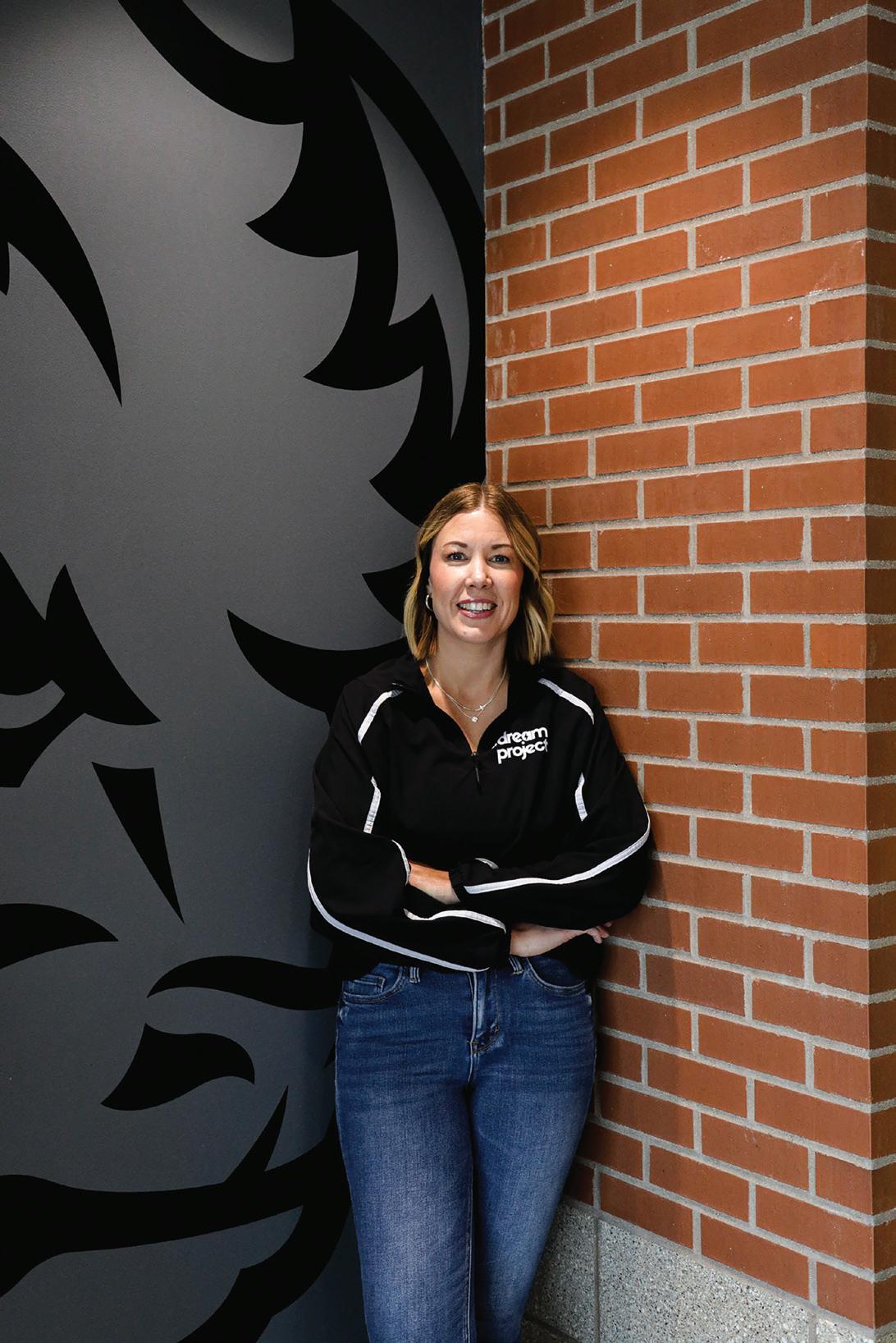


hen fans pack in to watch the Green & Gold perform, they see athletes who are fast, strong, and laser-focused on winning. What they don’t see is the invisible weight those same athletes carry—the pressure to perform, the strain of balancing academics and athletics, and the looming uncertainty of who they’ll be once their playing days are over.
That’s where Karli Moch comes in.
For the past two years, Moch has been quietly helping NDSU Athletics by bringing a holistic approach to student-athlete development that looks far beyond the scoreboard. Through her one-on-one coaching and group leadership sessions, she helps Bison athletes strengthen not only their performance on the court or field but also their well-being as whole people.
“We care about that whole person view rather than just performance,” Moch says. “It’s not only about how they compete, but who they are becoming as individuals.”
Moch’s work at NDSU is centered around the Dream Project, a coaching initiative she developed to equip athletes with tools for balancing life, leadership, and identity. Currently, she works with around 25 athletes across programs, including men’s and women’s basketball, and facilitates group leadership training for football.
Every athlete who meets with Moch goes through what she calls the “rhythm of life” framework, a system rooted in her certification through the Dream Manager Program. This framework evaluates well-being across four areas:
PHYSICAL: rest, nutrition, and movement
INTELLECTUAL: curiosity, growth, and lifelong learning
EMOTIONAL: healthy relationships and effective communication

SPIRITUAL: identity and purpose beyond athletics
“If you’re not well in these areas, you’re not performing at your best,” Moch said. “For athletes, that means burnout, strained relationships, or tying their entire worth to their performance. My role is to help them build resilience and a sense of identity outside of just being an athlete.”
Moch’s passion for this work didn’t come from theory—it came from a personal crisis. Early in her career, she was thriving in a global corporate role, chasing titles, money, and status. Then, within a matter of months, her world turned upside down.
Diagnosed with ulcerative colitis, she went from boardrooms to hospital rooms, enduring major surgery, the removal of her colon, and months of physical and emotional upheaval. That

I WANT THEM TO LEAVE HERE WITH SKILLS THAT MAKE THEM PRODUCTIVE MEMBERS OF OUR COMMUNITY, NOT JUST GREAT ATHLETES—BUT GREAT PEOPLE WHO CAN THRIVE OUTSIDE THOSE FOUR WALLS.”



experience forced her to confront the fragility of identity built solely on achievement.
“I thought I was at the top, and then it all came crashing down,” she said. “It stripped away every piece of my identity. It was like a midlife crisis at 30. For the first time, I realized my gifts needed to be used for serving others, not just building myself up.”
That wake-up call set her on a new path. After a stint leading development for the nonprofit BIO Girls, she connected with NDSU Athletics, where coaches quickly recognized the need for her skillset. What began as a trial year turned into a formal contract, and Moch has been pouring into Bison athletes ever since.
On paper, Moch’s one-on-one coaching sessions might look similar to mentoring or counseling, but in practice, they’re a unique blend of accountability, selfdiscovery, and skill-building.
Instead of probing into the past or focusing on therapy, she helps athletes clarify where they are now, where they want to go, and what steps they’ll take to get there.
“It’s not about asking them to tell me their whole childhood,” she said. “It’s about saying, ‘Okay, here’s what you say you want. Now, what are you going to do about it—and how can I hold you accountable?’”
That accountability is especially important in athletics, where every part of life is scheduled for the studentathlete: when to practice, when to eat, when to travel. Once they leave that structured environment, many are unprepared to manage their own time, priorities, and personal growth. Moch sees her role as helping them develop those tools before the safety net disappears.
“I want them to leave here with skills that make them productive members of our community,” she said. “Not just great athletes—but great people who can thrive outside those four walls.”
The challenges facing college athletes often go unnoticed. Beyond the physical toll of practices and games, there’s the emotional weight of balancing academics, performance, and relationships—all while living under a microscope of expectations from coaches, teammates, families, and media.
Moch has seen the toll firsthand. For many athletes, their identity is tightly bound to their performance. A poor game, a tough injury, or even a coach’s disapproval can shake their entire sense of self-worth.
“From a really young age, they’ve learned that love and approval often come with performance,” Moch said. “So when they’re injured or struggling, the spiral is real. My job is to help them see their worth outside of the stat sheet.”
Communication, too, is a constant hurdle. Moch spends significant time equipping athletes to have difficult conversations—whether with coaches



about playing time, teammates about accountability, or even family members about expectations. Learning how to ask for clarity, handle conflict, and maintain healthy relationships can be as valuable as any practice drill.
One of Moch’s goals is to break down the walls between athletics and the broader community. She often asks athletes what breaks their heart and then helps connect them with local nonprofits or service opportunities.
That volunteer work not only benefits the community but also gives athletes perspective.
“If you have a bad game, but you know you’re helping kids in a program you care about—it changes things,” Moch said. “It reminds them that they’re more than an athlete, and it gives them something bigger to pour into.”
While the conversations Moch facilitates are often deeply personal, the outcomes are tangible. She tracks athletes’ progress through pre- and post-program surveys, and the results point to growth in leadership skills, identity formation, and overall confidence.
Athletes who go through her coaching consistently report stronger relationships with teammates, improved communication, and a clearer sense of purpose beyond their sport. For coaches, that means more resilient leaders on the court and a healthier team culture. For the athletes, it means leaving NDSU with tools to thrive long after graduation.
“If they can handle conflict well, know who they are, and carry a sense of hope for their future, they’re going to succeed—no matter what happens in their sport,” Moch said.

Perhaps most remarkable is that Moch’s work is not happening on the margins — it’s fully embraced by NDSU Athletics. Under the leadership of Athletic Director Matt Larsen, the department has supported Moch’s role.
“NDSU cares about who these athletes are outside of the game,” Moch said. “It’s not just about wins and losses. They want to set these young men and women up for success in life.”
That commitment, she believes, also changes the way the broader community should view college athletics. While fans may see athletes as people who “get everything they want,” Moch is quick to point out the very human struggles they face—and the intentional work being done to support them.




ive generations in, Black Leg Ranch doesn’t just raise cattle and bison—it raises a flag for North Dakota. On 17,000 acres of native grasslands near the Missouri River, the Doan family has turned stewardship into a calling, pairing regenerative agriculture with a modern, hospitality-forward vision: destination lodging, guided hunts, directto-consumer beef and bison, and—fittingly for a state that loves its teams and its tailgates—Black Leg Brewery, home of Bison Beer and Bison Light.

That last piece is where the story intersects with North Dakota State University Athletics. The partnership—born in the early 2020s—connects a land-grant university with a land-anchored legacy, aligning campus pride with the ranch’s mission to care for soil, grasslands, wildlife, and community.
“We’re fifth-generation ranchers and bison producers,” Owner Jay Doan said. “My dad and brother are NDSU ag alumni, and our family has always respected the university’s impact on agriculture. Supporting NDSU Athletics with Bison Beer just makes sense—it reflects who we are and what North Dakota stands for.”
Black Leg’s brewing story begins under open sky. The ranch grows diverse cover crops on 3,000 additional acres, plants thousands of trees and shrubs for habitat each year, and manages a bison herd of roughly 500 head. That stewardship-first approach shapes the beer program, too. Black Leg uses pristine ranch water naturally filtered through the local rock bed and partners with nearby Two Track Malting—just minutes down the road—for malt sourced from North Dakota growers.
The result is a distinctly local pour with a sense of place. Bison Light (a lower-ABV option) is tailored to today’s fan experience—easy-drinking, crisp, and game-day friendly. Bison Beer is clean, balanced, and brewed to be shared at tailgates, watch parties, and post-win celebrations.
To protect the identity and keep it truly North Dakota, Black Leg federally trademarked “Bison” for beer, making sure the symbol of the plains stays right where it belongs—on the prairie, in the community, and, yes, in the stands.
JAY DOAN Owner





As a land-grant institution, NDSU’s legacy is inseparable from agriculture—education, research, and outreach that lift the state. Black Leg Ranch mirrors that mission on the land every day, turning regenerative practices into living education by rotating herds for soil health, building biodiversity, and modeling how working lands can thrive for another five generations.
“We want fans to enjoy great beer, but we also want them to know their beer can come from responsible, regenerative systems. When you support Bison Beer, you support North Dakota producers and the future of our grasslands,” Jay said.
That alignment is why Bison Beer and Bison Light are available at NDSU home games at the Fargodome, bringing the ranch-to-fan connection full circle on Saturdays. It’s also why Black Leg and NDSU continue to explore ways to deepen the partnership—especially around hands-on learning that prepares the next generation of ag leaders.




WHEN YOU RAISE A GLASS OF BISON LIGHT, YOU’RE RAISING A LITTLE BIT OF NORTH DAKOTA.”


The Doans are passionate about education that happens outdoors as much as in lecture halls.
The ranch regularly hosts guests from all 50 states and more than 60 countries, introducing visitors to working-lands conservation and the realities of modern ranching. Onsite, five lodges give students, alumni, and fans a spot to gather under big skies; a 13,000-square-foot Copper Jewell Barn handles events; and a new Bison Experience with takes small groups safely into the herd and the hills before returning for bison burgers perfectly paired with— what else—Bison Beer.




WITH BISON BEER JUST MAKES SENSE—IT REFLECTS WHO WE ARE AND WHAT NORTH DAKOTA STANDS FOR.”




Beyond the tap handle, Black Leg brings something unmistakable to the greenand-gold experience: the romance of the West. Cowboy hats at tailgates. Bison branding. A ranch that predates statehood (the family homesteaded here in the 1880s), showing up to celebrate a team that defines North Dakota toughness. It’s authentic. It’s local. And it’s exactly what college sports should feel like—communityfirst and proud of place.
“We want Bison fans to know the people behind the beer,” Jay said. “When you raise a can of Bison Light, you’re raising a little bit of North Dakota.”
Fans who want to experience the partnership beyond the pour can head to Black Leg Ranch to see regenerative agriculture in action: ride the prairie, meet the bison (safely), enjoy a burger, and clink glasses in the taproom. It’s the perfect way to connect gameday energy with the landscape that makes North Dakota, North Dakota.





When NDSU made the leap from Division II to Division I, the NCAA required proof that the school could sustain scholarships, facilities, and operating budgets at a higher level. That meant millions in guaranteed support had to be lined up. Team Makers members were the ones who supplied those resources. Their commitment made the transition possible, and everything that followed—nine FCS national championships, NFL draft picks, and national recognition—traces back to that decision.
This was the “system upgrade” that unlocked Dynasty Mode. Without that leap, NDSU would have stayed in a smaller division and the program would not be what it is today.

Join Team Makers at the $100 annual level. This is the same base-level support that fueled the original Division I move.

NDSU Teammakers is the official fundraising organization supporting North Dakota State University Athletics. Established to provide student-athletes with the resources they need to excel in competition, in the classroom, and in the community, Teammakers plays a vital role in sustaining the championship tradition of Bison Athletics. Through membership, corporate partnerships, and events, Teammakers helps fund athletic scholarships and enhances opportunities for more than 400 student-athletes across NDSU’s Division I programs.


Scholarships typically cover tuition, housing, and sometimes meals, but books and academic materials often aren’t included. These costs can run hundreds of dollars each semester and add up quickly. For student-athletes, who already balance classes, practice, travel, and competition, paying out-of-pocket for books is a challenge. Team Makers fills that gap and makes sure athletes have the academic tools they need.
It’s not flashy like new facilities, but it’s essential. Without books, athletes fall behind in class, and academic struggles can cost them eligibility.
Unlike independent NIL contributions, the Green & Gold Fund is administered by the NDSU Foundation. That means gifts are tax deductible and can be structured in financially savvy ways. For example, donors can transfer appreciated stock and avoid paying capital gains taxes while still earning Team Makers priority points. IRA rollovers and donor advised funds are also accepted, which gives fans flexible ways to maximize impact without increasing out-of-pocket costs.
This is a rare double win where you save money at tax time while the program gains scholarship and NIL funding. It is the kind of tool that keeps both the athletic department and donors ahead.


Financial: Set up a $25 monthly recurring gift, which adds up to the cost of an athlete’s books for a semester.
Non-Financial: Donate gently used class materials or volunteer as an academic tutor through alumni programs.
The Green and Gold Fund is North Dakota State University’s official NIL collective, created to give Bison student-athletes meaningful opportunities to benefit from their name, image, and likeness. Built on the support of alumni, fans, and local businesses, the fund provides student-athletes with resources to partner with community organizations, build their personal brands, and prepare for life beyond athletics. By aligning NIL opportunities with NDSU’s culture of integrity, teamwork, and excellence, the Green and Gold Fund helps student-athletes thrive while keeping Bison Athletics competitive at the highest level.


There’s a myth that athletic programs rely solely on a handful of wealthy boosters. At NDSU, the opposite is true. The majority of funds come from regular fans who consistently give modest amounts. That wide base of support creates stability because it doesn’t depend on just a few donors. It’s thousands of people contributing together to build a championship program.
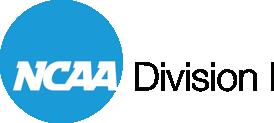
Beginning in 2025, schools participating in the House settlement can share revenue with athletes. NDSU chose to be part of this framework, which means athletes now receive compensation directly from the university in addition to scholarships and academic awards. This marks a historic shift in how student-athletes are supported and keeps NDSU competitive with programs nationwide.
This is a new link in the supply chain. For the first time, part of the money flowing through the system ends up directly in athletes’ bank accounts.
Scholarships were once the primary form of support, but gaps remained. Now athletes receive cost-of-attendance stipends and Alston academic achievement awards on top of scholarships. With direct pay added in, packages can reach several thousand dollars annually. This keeps athletes financially secure while they represent NDSU.
Financial: Give $250 to the Green & Gold Fund this year. These gifts help sustain the new compensation model.
Non-Financial: Share positive stories on social media about athletes benefiting from direct pay. Normalize this new era for fans.




At major universities, NIL is sometimes about six-figure endorsements. At NDSU, most NIL deals are small and practical. A $200 promotion can cover gas for away games, groceries for a month, or help with rent. That small boost can take away stress and allow an athlete to focus on training and competition.

Independent NIL collectives once handled donations, but NDSU has moved to a centralized system run through the NDSU Foundation. This guarantees compliance, tax deductibility, and transparency. It also simplifies things for fans: instead of navigating multiple organizations, there is one fund that counts toward Team Makers points and provides NIL dollars for athletes.
Financial: Hire an athlete for a $200 appearance or social media promotion. It’s often cheaper than a traditional ad buy.
Non-Financial: Follow and share athlete NIL posts to give them more visibility and help boost the value of their deals.

Financial: Sign up for a recurring $10 monthly gift to the Green & Gold Fund.
Non-Financial: Share the Fund’s website with your alumni chapter or fan group so more supporters use the official system.

The INFLCR platform is NDSU’s official NIL marketplace. It connects athletes and businesses in a compliant environment where both parties can propose and accept deals. This opens doors for small businesses that never thought NIL was within reach. With clear rules and no middlemen, it’s approachable for everyone.
It’s basically LinkedIn for NIL. Businesses list promotions or jobs, athletes sign on, and deals stay above board.





Learfield, a national leader in collegiate sports marketing and media, already controls media rights for NDSU athletics—from radio to scoreboard ads. Now they employ staff dedicated specifically to NIL partnerships. This means businesses have direct help creating, managing, and executing athlete deals. It professionalizes NIL at NDSU and helps ensure athletes are matched with quality opportunities.
Learfield acts like the supply chain’s logistics hub, moving advertising, sponsorship, and NIL opportunities where they’re needed.
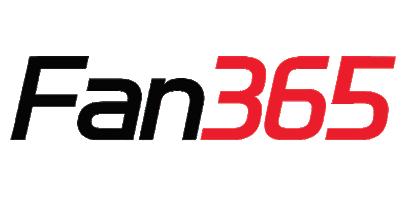
Fan365 isn’t generic digital marketing. It leverages data about Bison fan behavior, ticket usage, and game-day engagement to deliver targeted campaigns. At NDSU, these campaigns have produced millions of impressions with performance levels 250 percent higher than standard ads. That’s proof that tying into the Bison brand amplifies business visibility.
It’s the digital version of selling out the Dome—loyal fans engaging with sponsor content at unmatched rates.
Ask Learfield Bison Sports Properties about bundling an NIL partnership with scoreboard or radio advertising.


Financial: Work with Learfield to run a Fan365 campaign for your business, even on a small scale.
Non-Financial: As a fan, click, share, and engage with sponsor campaigns. Your interaction makes the advertising more valuable.
That includes radio broadcasts, TV shows, arena signage, digital advertising, and even hospitality packages. If a business wants official visibility in the Bison ecosystem, Learfield’s Bison Sports Properties is the gateway. This structure ensures consistent quality and coordination across all sponsor platforms.
Financial: Partner with Learfield for a small in-game sponsorship, like a radio read or scoreboard ad.
Non-Financial: Thank and patronize businesses you see sponsoring Bison events—they’re reinvesting in the program.




Despite Fargo’s modest population size, the Fargodome regularly hosts crowds of more than 18,000, outdrawing schools with bigger budgets and larger metro areas. That’s proof of the brand strength NDSU has built and the loyalty of its fanbase. The demand for Bison football is stronger than the market size would suggest.

With over 18,000 fans in the Fargodome on a typical Saturday, a small one-time gift from each could raise nearly $400,000. That is enough to cover tuition, fees, and living costs for more than 20 athletes for an entire year. It shows how collective action creates outsized impact.

Financial: Buy a season ticket package or bring guests to a game.
Non-Financial: Post your game-day photos and tag NDSU. Visibility online shows recruits and prospects how powerful the fanbase really is.
Financial: Donate $20 at the next game or through the Team Makers portal.
Non-Financial: Share this fact with your section of the Dome. If everyone does it, the ripple effect is massive.


When alumni connect with athletes, they open doors to internships, jobs, and professional networks. These opportunities create long-term career security and stability, often more valuable than a one-time check. For many athletes, a conversation with a professional alum can shape their path after sports.

Recruits and their families notice how often they see a program represented in airports, conferences, and other cities. It signals national visibility and fan passion. For NDSU, seeing the green and gold away from North Dakota reinforces the program’s reach.

Financial: Add a small donation earmarked for athlete academic services.
Non-Financial: Offer to meet an athlete for coffee or review a résumé through alumni mentoring programs.
Financial: Buy an extra piece of official NDSU apparel—ideally athlete-branded through the NIL store.
Non-Financial: Wear your Bison gear when traveling or at national events. The brand impression spreads further than you think.


This includes volunteering at schools, food pantries, hospitals, and youth camps across Fargo and the region. Those hours surpass what many Fortune 500 companies average per employee in community service. It shows how deeply athletes are woven into the local community fabric

Hotels, restaurants, shops, and services all experience a surge on game weekends. That spending circulates through the community long after the games are over, supporting local jobs and businesses. A strong athletics program becomes a local economic driver.
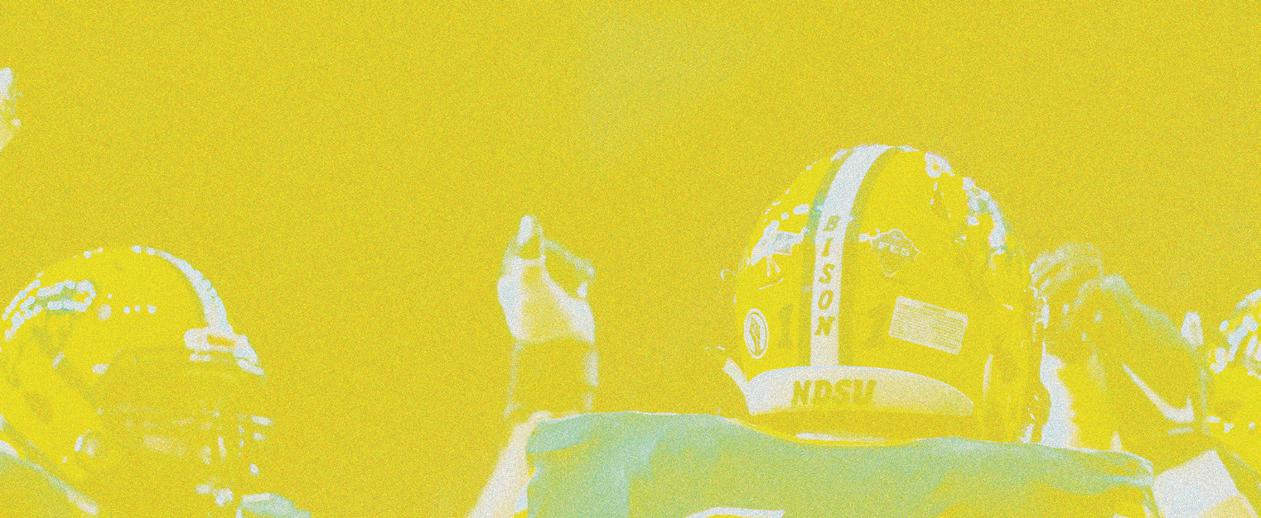



Carson Wentz, Billy Turner, Christian Watson, Cody Mauch, Grey Zabel, and other Bison alumni highlight a pro pipeline that has been built through scholarship support and facilities investments. NFL scouts see Fargo as a legitimate recruiting stop, which elevates the entire program’s profile.
Your support today helps develop the next pro. You might be sponsoring a future Super Bowl starter.

When the football program wins national championships, overall applications to the university rise—even in non-athletic majors. Athletics acts as a marketing campaign that spreads brand awareness nationally. This means athletic success has a direct impact on academic growth.


One of the most important elements of the NCAA v. House settlement is the ability to directly support student-athletes through Institutional NIL (Name, Image and Likeness). At NDSU that means the generous contributions you make — especially tax-deductible gifts to the Green and Gold Fund — are now eligible to be part of this shared revenue model. These funds managed by NDSU Athletics will be another way to provide financial resources for our student-athletes, which is critical for recruitment and retention.

The Green and Gold Fund can be supported via one-time or recurring online gifts, donor-advised funds, stock donations, IRA distributions, or check. All contributions to the Green and Gold Fund are a gift to Team Makers, and qualify for Team Maker Club benefits and priority points (1 point per $50 donated). Donors have the option to give monthly, or make an annual gift.
• WELCOME PACKET
• INVITATION TO EXCLUSIVE GREEN AND GOLD FUND EVENT (ONE EVENT ANNUALLY)
• OPPORTUNITY TO ATTEND A TEAM PRACTICE

• WELCOME PACKET
• INVITATION TO EXCLUSIVE GREEN AND GOLD FUND EVENT (ONE EVENT ANNUALLY)
• OPPORTUNITY TO ATTEND A TEAM PRACTICE
• FREE ENTRY TO QUARTERLY RAFFLES
• QUARTERLY VIRTUAL MEET-AND-GREET WITH COACHES AND STUDENT-ATHLETES

• WELCOME PACKET
• INVITATION TO EXCLUSIVE GREEN AND GOLD FUND EVENT (ONE EVENT ANNU UY)
• OPPORTUNITY TO ATTEND A TEAM PRACTICE
• FREE ENTRY TO QUARTERLY RAFFLES
• QUARTERLY VIRTUAL MEET-AND-GREET WITH COACHES AND STUDENT-ATHLETES
• EXCLUSIVE HAT
• TWO TEAM MAKERS TUNNEL CREDENTIAL LS TO ONE GAME (GAME TO BE DETERMINED BY MDSU ATHLITICS STAFF)

• WELCOME PACKET
• INVITATION TO EXCLUSIVE GREEN AND GOLD FUND EVENT (ONE EVENT ANNUALLY)
• OPPORTUNITY TO ATTEND A TEAM PRACTICE
• FREE ENTRY TO QUARTERLY RAFFLES
• QUARTERLY VIRTUAL MEET-AND-GREET WITH COACHES AND STUDENT-ATHLETES
• EXCLUSIVE HAT AND SHIRT
• FOUR TEAM MAKERS TUNNEL CREDENTIALS TO ONE GAME (GAME TO BE DETERMINED BY NDSU ATHLETICS STAFF)
• TWO RADIO FM SUITE SEASON LONG PASSES
• QUARTERLY SIDELINE FOOTBALL EXPERIENCE SWEEPSTAKES
Scan the QR code to become a Team Maker today and select your donation bracket!



